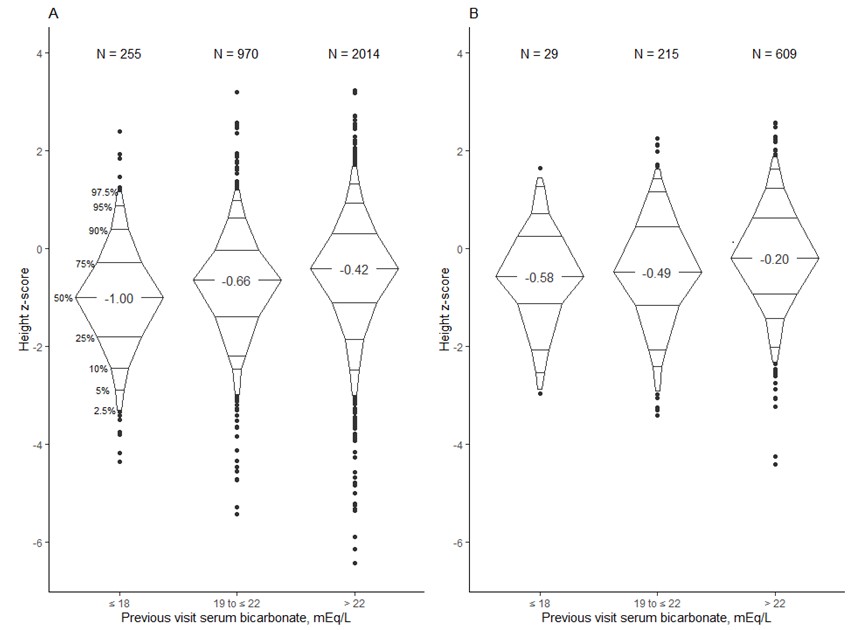Back
Nephrology: CKD
Category: Abstract Submission
Nephrology IV: Chronic Kidney Disease
64 - Longitudinal Associations Between Low Serum Bicarbonate and Linear Growth In Children Enrolled In The Chronic Kidney Disease In Children Study.
Sunday, April 24, 2022
3:30 PM – 6:00 PM US MT
Poster Number: 64
Publication Number: 64.341
Publication Number: 64.341
Denver D. Brown, Children's National Health System, Washington, DC, United States; Megan Carroll, Verily Life Sciences, San Francisco, CA, United States; Derek K. Ng, Johns Hopkins Bloomberg School of Public Health, Baltimore, MD, United States; Rebecca Levy, University of Rochester School of Medicine and Dentistry, Rochester, NY, United States; Larry A. Greenbaum, Emory University, ATLANTA, GA, United States; Frederick kaskel, Children's Hospital at Montefiore, Albert Einstein College of Medicine, Bronx, NY, United States; Susan Furth, Childrens Hospital of Philadelphia, Philadelphia, PA, United States; BRADLEY A. WARADY, CHILDREN'S MERCY KANSAS CITY, KANSAS CITY, MO, United States; Michal Melamed, Albert Einstein College of Medicine, Bronx, NY, United States; Andrew Dauber, Children's National Health System, Washington, DC, United States

Denver D. Brown, MD (she/her/hers)
Assistant Professor
Children's National Health System
Washington, District of Columbia, United States
Presenting Author(s)
Background: Poor linear growth is a consequence of chronic kidney disease (CKD) that has been linked to adverse outcomes. Metabolic acidosis (MA) has been identified as a risk factor for growth failure.
Objective: We investigated the longitudinal relationship between MA and linear growth in children with CKD and examined whether treatment of MA modified linear growth.
Design/Methods: To describe longitudinal associations between MA and linear growth, we used serum bicarbonate levels, height measurements and standard deviation (z-scores) of children enrolled in the prospective cohort study, Chronic Kidney Disease in Children. Analyses were adjusted for covariates recognized as correlating with poor growth including demographic characteristics, glomerular filtration rate (GFR), proteinuria, calcium, phosphate, parathyroid hormone, and CKD duration. CKD diagnoses were analyzed by disease categories, non-glomerular or glomerular.
Results: The study population included 1082 children with CKD: 808 with non-glomerular etiologies and 274 with glomerular etiologies. Baseline serum bicarbonate levels ≤22mEq/L were associated with worse height z-scores in all children. Longitudinally, serum bicarbonate levels ≤18mEq/L and 19-22mEq/L were associated with worse height z-scores in children with non-glomerular CKD causes, with adjusted mean values of -0.39, (95%CI: -0.58, -0.20) and -0.17, (95%CI: -0.28, -0.05), respectively. Children with non-glomerular disease and more severe GFR impairment had a higher risk for worse height z-score. A significant association was not found in children with glomerular diseases. We also investigated the potential effect of treatment of MA on height in children with a history of alkali therapy use finding that only persistent users had a significant positive association between their height z-score and higher serum bicarbonate levels.Conclusion(s): We observed a longitudinal association between MA and lower height z-score. Additionally, persistent alkali therapy use was associated with better height z-scores. Future clinical trials of alkali therapy need to prospectively evaluate this relationship.
Figure 1. Distribution of height z-score by previous visit bicarbonate levels among person-visits contributed by participants with (A) non-glomerular and (B) glomerular CKD diagnoses.
Distribution of height z-score by previous visit bicarbonate levels among person-visits contributed by participants with (A) non-glomerular and (B) glomerular CKD diagnoses.
Table 1..jpg) Unadjusted, partially adjusted, and fully adjusted models of height z-score on serum bicarbonate, using a categorical predictor. Bold indicates p < 0.05.
Unadjusted, partially adjusted, and fully adjusted models of height z-score on serum bicarbonate, using a categorical predictor. Bold indicates p < 0.05.
Objective: We investigated the longitudinal relationship between MA and linear growth in children with CKD and examined whether treatment of MA modified linear growth.
Design/Methods: To describe longitudinal associations between MA and linear growth, we used serum bicarbonate levels, height measurements and standard deviation (z-scores) of children enrolled in the prospective cohort study, Chronic Kidney Disease in Children. Analyses were adjusted for covariates recognized as correlating with poor growth including demographic characteristics, glomerular filtration rate (GFR), proteinuria, calcium, phosphate, parathyroid hormone, and CKD duration. CKD diagnoses were analyzed by disease categories, non-glomerular or glomerular.
Results: The study population included 1082 children with CKD: 808 with non-glomerular etiologies and 274 with glomerular etiologies. Baseline serum bicarbonate levels ≤22mEq/L were associated with worse height z-scores in all children. Longitudinally, serum bicarbonate levels ≤18mEq/L and 19-22mEq/L were associated with worse height z-scores in children with non-glomerular CKD causes, with adjusted mean values of -0.39, (95%CI: -0.58, -0.20) and -0.17, (95%CI: -0.28, -0.05), respectively. Children with non-glomerular disease and more severe GFR impairment had a higher risk for worse height z-score. A significant association was not found in children with glomerular diseases. We also investigated the potential effect of treatment of MA on height in children with a history of alkali therapy use finding that only persistent users had a significant positive association between their height z-score and higher serum bicarbonate levels.Conclusion(s): We observed a longitudinal association between MA and lower height z-score. Additionally, persistent alkali therapy use was associated with better height z-scores. Future clinical trials of alkali therapy need to prospectively evaluate this relationship.
Figure 1.
 Distribution of height z-score by previous visit bicarbonate levels among person-visits contributed by participants with (A) non-glomerular and (B) glomerular CKD diagnoses.
Distribution of height z-score by previous visit bicarbonate levels among person-visits contributed by participants with (A) non-glomerular and (B) glomerular CKD diagnoses.Table 1.
.jpg) Unadjusted, partially adjusted, and fully adjusted models of height z-score on serum bicarbonate, using a categorical predictor. Bold indicates p < 0.05.
Unadjusted, partially adjusted, and fully adjusted models of height z-score on serum bicarbonate, using a categorical predictor. Bold indicates p < 0.05.